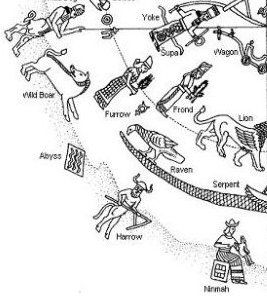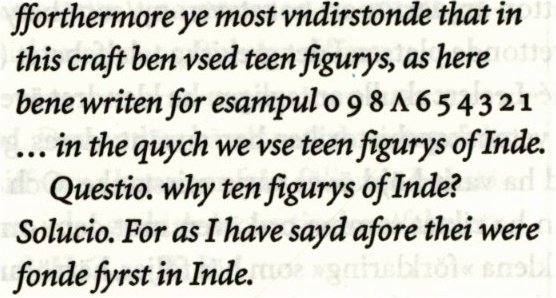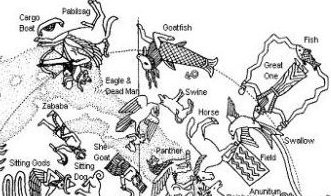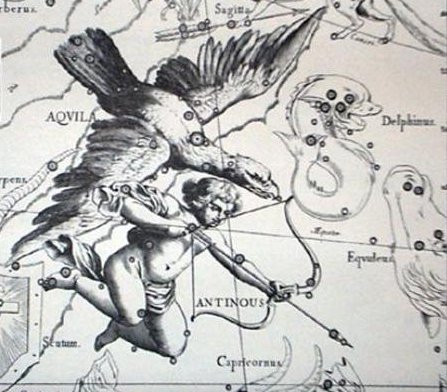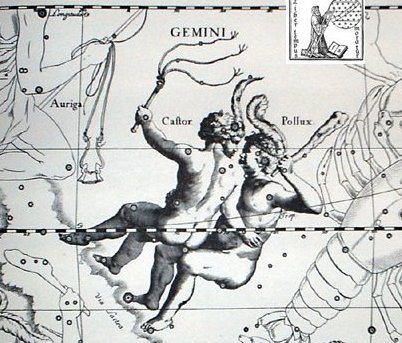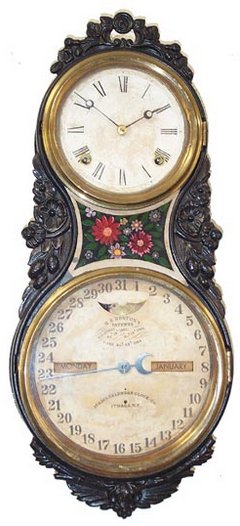We are, however, not yet prepared to advance further into this particular labyrinth of time-space. Instead let's move on. From NOVEMBER 1 up to and including the π day there were 10 days, ending at nakshatra Pollux, at the Front of the Mouth of the Twins:
These Twins were those who once climbed up onto Land (the Great Twins) and when they half a year later came close to the Full Moon it ought to have been where the Sun was leaving Land again. ... In Hindu legend there was a mother goddess called Aditi, who had seven offspring. She is called 'Mother of the Gods'. Aditi, whose name means 'free, unbounded, infinity' was assigned in the ancient lists of constellations as the regent of the asterism Punarvasu. Punarvasu is dual in form and means 'The Doublegood Pair'. The singular form of this noun is used to refer to the star Pollux. It is not difficult to surmise that the other member of the Doublegood Pair was Castor. Then the constellation Punarvasu is quite equivalent to our Gemini, the Twins. In far antiquity (5800 B.C.) the spring equinoctial point was predicted by the heliacal rising of the Twins ...
... Men's spirits were thought to dwell in the Milky Way between incarnations. This conception has been handed down as an Orphic and Pythagorean tradition fitting into the frame of the migration of the soul. Macrobius, who has provided the broadest report on the matter, has it that souls ascend by way of Capricorn, and then, in order to be reborn, descend again through the 'Gate of Cancer'. Macrobius talks of signs; the constellations rising at the solstices in his time (and still in ours) were Gemini and Sagittarius: the 'Gate of Cancer' means Gemini. In fact, he states explicitly (I,12.5) that this 'Gate' is 'where the Zodiac and the Milky Way intersect' ... In rongorongo times this time of leaving Land evidently could have happened in night 378, alluding to the synodic cycle of Saturn whose sign was at the beginning of the 4th quadrant. 4 / 3 * 378 = 504 = 7 * 72.
But it was the Eagle who later would lift the Dead Man in his claws, transporting him across the waters:
504 - 123 = 379:
The little piece of Land which remained (123 days) could evidently have been reflected in the night sky by the little Sea which remained after the Eagle had lifted up the Dead Man - which happened at the end of the 4th quadrant in time-space.
The 3 footprints of Sravana were probably alluding to the 3 feet which were up on Land, with the left foot of Castor still down in the water - at the beginning of the new Land. Whereas Pollux was immortal. An ear is marking the point where the face changes to the back side of the head and an ear is also the vehicle for later returning to life (to incarnate).
So Castor had a double nature, with his Ghost the day before his star. In the night when Altair was with the Sun it was φ Gemini (at the left shoulder of Pollux) which was close to the Full Moon and which opened up the 'mouth' to the new year - 6 nights after the enigmatic q Gemini. At the time of the Hyades Gate this happened in night 499 (MAY 14, 5-14) and in rongorongo times it happened 118 (= a quarter of 472) nights after 0h.
... Its [the Ghost's] leading star is said to be 'q Cancri'. Strangely the internet site Chinese Astronomy never uses Greek letters for the stars, e.g. is Tejat Posterior (μ Gemini) referred to as 'm Gemini'. However, there is no Greek letter corresponding to the letter 'q'. Possibly the idea is to refer to the ancient Greek letter koppa, a reasonable sign for something dead and only living on in peoples' minds. There is no star q Cancri (or similar) according to Wikipedia ... Q with his tail hanging down was only the 'ghost' of a true letter, only an 'ape', and it occurred when Antares culminated at midnight.
A man-like creature could once upon a time have arrived safely up on Land at the opposite side of the year compared to his immortal twin brother Pollux. In the New World there were no apes, but there were monkeys (with tails):
Early I noticed the pair Gb1-6--7, which induced me to count. Clearly there were 236 glyphs from Gb1-7 to the end of the text. But there were only 235 glyphs from the beginning of side a. After much thought I decided it had to be time which counted and that 236 = 8 * 29½ should be balanced by an equal amount - its twin - on the front side of the text. It was like the face of an old-fashioned clock, where its first number (1) indicated where the first hour had been completed. I.e. the first glyph on side a marked midnight after the first day had been completed in full and the next day was beginning.
16 lunar synodic months were described on the tablet; 8 * 59 nights. A kind of the reason behind the shorter text on side a can now be perceived:
An old-fashioned clock has twin cycles for the diurnal cycle and π has to be counted twice for measuring its whole perimeter.
The idea goes back as far as history can reach. Hamlet's Mill: "... it is told that he [Gilgamesh] lives in splendor and dissoluteness, and makes a nuisance of himself until the gods bring relief to his people by rearing a human being, either twin or counterpart,³ who can stand up to him. It is Enkidu, the man of the Wilds, a kind of wolf-child as simple as the beasts he plays with, a happy son of nature, hairy all over, grown to enormous strength ... ³ Actually, the goddess Aruru makes him 'in the likeness of Anu', literally 'a zikru of Anu she conceived in her heart'. But Enkidu is also said to look like Gilgamesh 'to a hair' ..." |
|||||||||||||||||||||||||||||||||||||||||||||||||||||||||||||||||||||||||||||||||||||||||||||||||||||||||||||||||||||||||||||||||||||||||||||||||||||||||||||||||||||||||||||||||||||||||||||||||||||









